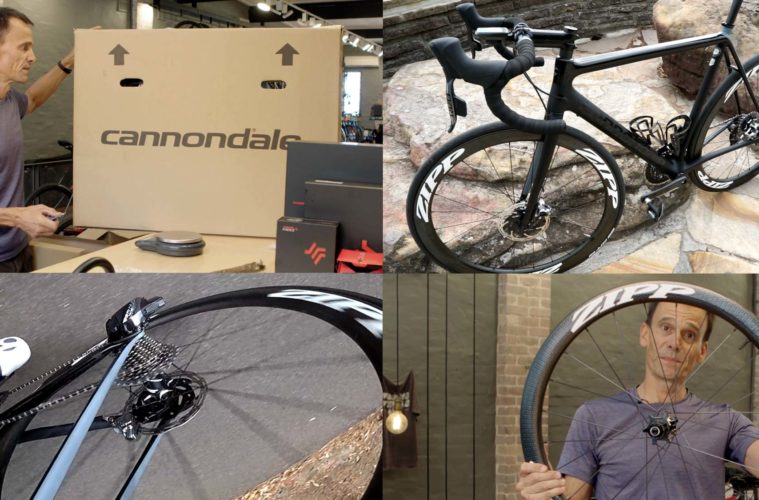[et_pb_section bb_built=”1″ admin_label=”section”][et_pb_row admin_label=”row”][et_pb_column type=”1_4″][et_pb_text use_border_color=”off” border_color=”#ffffff” border_style=”solid” _builder_version=”3.12″]
In part three of RIDE Media’s review of the SRAM AXS wireless electronic 12-speed groupset, Rob Arnold unboxes the frame and parts to be used for the bike test…
[/et_pb_text][/et_pb_column][et_pb_column type=”3_4″][et_pb_text use_border_color=”off” border_color=”#ffffff” border_style=”solid” _builder_version=”3.12″]
To better understand a new cycling groupset, it’s best to ride it. Before that can happen, however, a bike has to be built. During that process, you learn a lot more about what the highlights of an ensemble are.
Here’s a little bit of what we already know about SRAM’s new Red eTap AXS groupset: it is 12-speed electronic shifting with an entirely redesigned (thin) chain, new cassette, different derailleurs (albeit using the same batteries as the first iteration of Red eTap)… it is lighter than before and comes with a complete rethink about gearing ratios.
The 10-tooth rear cog allows SRAM to bring innovations that have existed on other types of bikes to road cycling.
In episode one of our SRAM AXS review, the groupset gets unboxed and each part is weighed.
For episode two, we visit the workshop at Wooly’s Wheels and let Paul Wootton explain some of the details that make the components easy for mechanics to work with.
In episode three (below), we take a look at the other components – and the frame – that will be used for the duration of the review.
– Click the YouTube link to watch part 3 –
[/et_pb_text][/et_pb_column][/et_pb_row][et_pb_row][et_pb_column type=”4_4″][et_pb_video _builder_version=”3.12″ src=”https://youtu.be/uato71011cw” /][/et_pb_column][/et_pb_row][et_pb_row][et_pb_column type=”1_4″][et_pb_text use_border_color=”off” border_color=”#ffffff” border_style=”solid” _builder_version=”3.12″]
Subscribe to RIDE Media on YouTube to receive notifications about new uploads…
[/et_pb_text][/et_pb_column][et_pb_column type=”3_4″][et_pb_text use_border_color=”off” border_color=”#ffffff” border_style=”solid” _builder_version=”3.12″]
Let’s be clear, we do care about naming protocols – despite what may have been uttered in part three of our SRAM AXS review – and one of the reasons is that it eliminates the element of surprise at the unboxing.
Imagine you’re expecting a Cannondale System-Six frame and you open the box to find a Cannondale Super-Six… it would be quite a surprise if you were a paying customer.
There is a difference in the name, and a lot of differences in the frames… but because we rushed things through to ensure that a review bike could be shipped nice and early, I wasn’t paying a lot of attention to the details while doing the planning. Imagine, then, my surprise when what I thought would be an oversize aero frame turned out to be a svelte 895g climbing frame.
That is what happened a little over a week ago. You can see from my reaction in the video that it caught me off-guard… but, at the same time, didn’t necessarily make me unhappy.
Cannondales are great bikes to ride. I’ve been on virtually every iteration of the CAAD series – and own a CAAD7 ‘Black Lightning’ special edition from 2002.
The Super-Six, like many modern bikes, is now disc brake ready (even though it is yet to receive the thru-axle treatment for the rear wheel). This is the frame that we will use for the review of the AXS groupset.
[/et_pb_text][/et_pb_column][/et_pb_row][et_pb_row][et_pb_column type=”4_4″][et_pb_image animation=”left” sticky=”off” use_border_color=”off” border_color=”#ffffff” border_style=”solid” _builder_version=”3.12″ src=”https://www.ridemedia.com.au/wp-content/uploads/2019/02/Cannondale-box.jpg” /][/et_pb_column][/et_pb_row][et_pb_row][et_pb_column type=”1_4″][et_pb_text use_border_color=”off” border_color=”#ffffff” border_style=”solid” _builder_version=”3.12″]
What’s in the box (above)… a surprise awaits.
[/et_pb_text][/et_pb_column][et_pb_column type=”3_4″][et_pb_text use_border_color=”off” border_color=”#ffffff” border_style=”solid” _builder_version=”3.12″]
The third in this ongoing series of YouTube reviews doesn’t offer much technical information. It is a little irreverent and shows off the product from a range of angles before we get into the nitty gritty of AXS’s special features. Sometimes, I believe, it is important not to take cycling too seriously.
In the week that the first two episodes were online, the reactions featured a surprising amount of negativity about this innovative product from SRAM. Much of the criticism is to do with the price, some relates to the gear ratios – and the commitment a customer needs to make about the chainring sizes upon purchase.
Not much of the commentary offered on RIDE Media’s YouTube channel acknowledges that SRAM is striving to make cycling more modern by utilising new tech that actually improves the ride quality. The initial negativity is, however, likely to abate. Why? Quite simply, because the product is good.
After a few rides on AXS, I’m convinced that – although it is expensive – it is going to get considerable traction in the market.
[/et_pb_text][/et_pb_column][/et_pb_row][et_pb_row][et_pb_column type=”4_4″][et_pb_image animation=”left” sticky=”off” use_border_color=”off” border_color=”#ffffff” border_style=”solid” _builder_version=”3.12″ src=”https://www.ridemedia.com.au/wp-content/uploads/2019/02/Zipp-Wheels.jpg” /][/et_pb_column][/et_pb_row][et_pb_row][et_pb_column type=”1_4″][et_pb_text use_border_color=”off” border_color=”#ffffff” border_style=”solid” _builder_version=”3.12″]
Zipp, part of the SRAM family of products, is part of the build kit…
[/et_pb_text][/et_pb_column][et_pb_column type=”3_4″][et_pb_text use_border_color=”off” border_color=”#ffffff” border_style=”solid” _builder_version=”3.12″]
Of course, if you spend around $10k on a bike, you want it to be nice. That has been the case for years and customers have been willing to make such an investment if it means a quality ride.
SRAM combines beautifully with Zipp components and a Cannondale Super-Six Evo frame to make a special bike. In the near future, we will add to this review series with observations about the ride characteristics, and how the AXS groupset functions in real-world tests. We will examine the benefits of the associated app and find out more about what makes this ensemble such a revolution for cycling.
In the meantime, you can watch another clip of me talking about bike bits as I pull them out of a box.
Please be sure to subscribe to RIDE Media on YouTube and don’t be shy when it comes to offering a comment, feedback is encouraged and it is interesting to note what our readers/viewers think of products like this.
SRAM AXS may not be for everyone but, in time, we can assume that many of the concepts raised with the release of this latest groupset will become common in the cycling market. And it will happen that way because many of them make a lot of sense.
– By Rob Arnold
[/et_pb_text][/et_pb_column][/et_pb_row][et_pb_row][et_pb_column type=”4_4″][et_pb_image animation=”left” sticky=”off” use_border_color=”off” border_color=”#ffffff” border_style=”solid” _builder_version=”3.12″ src=”https://www.ridemedia.com.au/wp-content/uploads/2019/02/Riding-Cassette.jpg” /][/et_pb_column][/et_pb_row][/et_pb_section]


